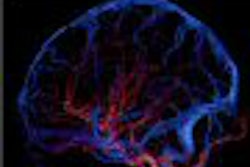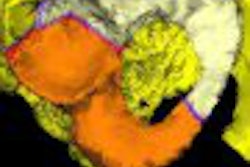Nitroglycerin significantly improves the results of coronary CT angiography (CTA) by dilating the coronary arteries before scanning, researchers in Belgium have reported. Their study found that vessel lumen diameters and average volumes were larger when nitroglycerin spray was administered sublingually before scanning.
Long used for dilatation of epicardial coronary arteries at angiography, "organic nitrates are potent vasodilators that dilate both normal and abnormal coronary arteries by relaxing vascular smooth muscle," noted Dr. Isabel Decramer, Dr. Piet Vanhoenacker from OLV Ziekenhuis in Oost Vlaanderen, Belgium, and colleagues from two other Belgian centers.
Nitrates have also been used at coronary CTA to improve visualization of small vessels, side branches, and the distal portions of main coronary arteries that are not always optimally visualized, they noted.
"However, the effects of nitroglycerin to dilate the lumen of coronary arteries have not been extensively documented or quantified," the group wrote (American Journal of Roentgenology, January 2008, Vol. 120:1, pp. 219-225).
In order to assess the effect of nitroglycerin at CTA without scanning patients twice, the study split its final cohort of 42 patients (27 men, 15 women, ages 18-79 years, mean age 56.1) into two groups: 21 who were examined without sublingual nitroglycerin (group A); and another 21 patients who were examined after nitroglycerin administration (group B).
All patients had been referred for coronary CT angiography. The protocol excluded candidates with coronary calcium scores greater than 400, those with previous stent implantation or bypass surgery, those over age 70, and those with body mass index greater than 25 kg/m2, or heart rates faster than 70 bpm.
Patients with baseline heart rates of 65 bpm or greater were given a beta-blocker (25-100 mg metropolol, 1 mg/mL). Those in group B were given a single dose of nitroglycerin as a sublingual spray (0.4 mg/L) five minutes before scanning.
Following a calcium scoring scan, coronary CTA was performed using a 64-detector-row scanner (Somatom 64, Siemens Medical Solutions, Erlangen, Germany). Settings included 120 kVp, 145 mAs tube current, 330 msec gantry rotation speed, 64 x 0.6-mm collimation and 0.4 mm reconstruction interval.
Two experienced observers, blinded to patient group and working by consensus, quantitatively assessed lumen diameter and volume in the left anterior descending (LAD) artery and right coronary artery (RCA). They counted the number of septal branches originating from the proximal and mid-left LAD. The sinoatrial and conus branches were denoted as present or absent, although these are not considered clinically significant.
"We wanted to determine whether nitroglycerin improves visualization of these small vessels as a surrogate marker for improved vessel visualization," the authors explained.
Finally, signal-to-noise radio and contrast-to-noise ratio were measured at multiple regions of interest, and vessel volume and average vessel cross-section diameter were evaluated in the LAD and RCA using curved MPR reconstructions.
The results showed that lumen diameters and average volumes were significantly larger in the nitroglycerin group (B) compared to group A. The average RCA lumen diameter for patients in group A and group B was 2.63 mm (95% CI, 2.47-2.80 mm) and 3.48 mm (95% CI, 3.27-3.69 mm), respectively. The average volume for patients in group A and group B was 2.67 mm (2.50-2.85 mm) and 3.42 mm (3.20-3.65 mm) (p < 0.0001), respectively, the authors wrote.
There was also a statistically significant difference in the number of visible septal branches between groups A and B (Student's t test, p < 0.001). "The sinoatrial branch was present in 67% of group A compared with 95% of group B (Fisher's exact test, p = 0.069), and the conus branch was present in 33% of group A compared with 62% of group B (Fisher's exact test, p= 0.129)," the authors wrote, though the difference was not statistically significant.
No difference in side effects was noted between the groups.
"The results of this study show that more septal branches could be visualized when patients received sublingual nitroglycerin spray before scanning," the group reported. "The administration of sublingual nitroglycerin spray also led to a significant increase in volume in both the RCA and the LAD. Also, the diameters in those arteries were significantly larger and within the range of normal dimensions of the coronary arteries, as seen on conventional angiography. The effect is important and reached statistical significance even with a rather small sample."
Primary among the study's limitations was that the group did not examine diagnostic accuracy for the detection of significant stenoses based on the small sample size and low-to-intermediate pretest probability of coronary artery disease. The fact that two separate though demographically similar groups were studied was also a limitation, the authors acknowledged.
"Prior to the administration of nitroglycerin, patients should be questioned regarding the recent use of Viagra (sildenafil), Cialis (tadalifil), or Levitra (vardenafil)," cautioned AJR editors Dr. Patrick Colletti and Dr. Robert Stanley in a written commentary. "Severe side effects, including very low blood pressure and death, have been reported in patients given nitroglycerin within 24 hours after use of phosphodiesterase type 5 inhibitors" (AJR, January 2008, Vol. 120:1, p. 224).
By Eric BarnesAuntMinnie.com staff writer
December 31, 2007
Related Reading
Calcium scoring requires individualized reconstruction phases, March 5, 2007
Advanced visualization alone reduces coronary CTA accuracy. December 22, 2006
Cardiac CTA a no-go zone for some, July 17, 2006
Dual-source imaging promises better CT scanning, June 15, 2006
Copyright © 2007 AuntMinnie.com




















